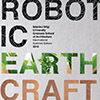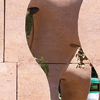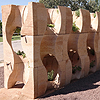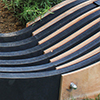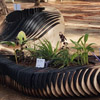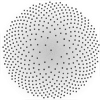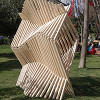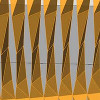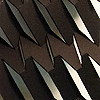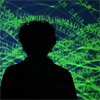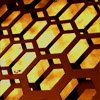Can digital design and robot technology be integrated with an ecological design approach? The robotic earthcrafts workshop at Istanbul Bilgi University attempts to relate to biological parameters and digital design and fabrication processes. Thus, the summer school will include seminars and practices on computational design, robotic fabrication, rammed-earth construction techniques, and permaculture design principles to discuss and experience the relationships between technology and ecology. So, the results will be the […]
Posts categorized under Practice
This is the basketball cup that won the design contest organized in 2018 by the Turkish Basketball Federation (TBF). Nadide Ebru Yazar and Mete Yazar proposed this idea, and I modeled that in Rhino and rendered it with Neon. Among more than 150 designs, the jury chose our design due to its dynamic formal expression. Cage-editing was very efficient in creating this kind of free-form surface. However, the production phase […]
The “Common-Action Wall” Project of the POTplus Design Research Group, founded by Fulya Akipek and Tuğrul Yazar from BİLGİ Faculty of Architecture, got an honorable mention in the category of “Completed Projects/Small Projects” in “S.ARCH 2018 Project Award”. For detailed information about the “Common-Action Walls” Project, please click here and here For detailed information about “S.ARCH: The 5th International Conference on Architecture & Built Environment + AWARDs”, please click here. Members of the Jury: Toyo Ito, Toyo Ito & Associates, […]
The website of our design works with Fulya Akipek is now open. You can check it here: www.potplus.org According to the website; Which sources feed the creative energy of current architecture in an agenda where crisis and opportunities encounter? In what kinds of productions is this energy being used for? How does architecture relate to channels of everyday life; does it reveal, highlight or transform any existing relations? Does architecture […]
Here is the abstract of my last publication in the International Journal of Architectural Computing. Parquet Deformations is an architectural studio exercise of William Huff in the 1960s. It aims to improve students’ reasoning of spatiotemporal variation by utilizing sequential shape-shifting of patterns. This article examines the outcomes of this educational research from the perspective of design computing. A multilayered reading about the exercise will reveal its historical, theoretical, and artistic backgrounds. Then […]
In 2017, during the 4th International Architecture Biennial of Antalya, we constructed the Common-action Wall in Karaalioğlu Park. We designed this architectural prototype as a wall that enables the growth and harvesting of edible plants for park users. To facilitate plant growth and ensure sunlight access, as well as to direct rainwater toward the plants, we conducted extensive studies on minimal surfaces. Ultimately, we found that the gyroid form met […]
Scientific publications are expected to relate to all areas of science they sprawl. For this, the scientific publication is associated with several keywords that are thought to be related. For proper access to scientific publications in literature research, keyword assignment is as important as the publication title. This study aimed to map the usage patterns of the concepts related to the field of digital design research through keyword analysis. The […]
It has been nearly 2 years since we designed and produced this garden. Similar to the first version, Common-action Gardens #2 is injected in formal park layouts. We build it for recreation as garden structures with an aim to support the “preserve, sustain, and share” idea. Thus, we expect to bring people together while producing. These gardens organize sustainable models for communal living by integrating raised beds, planting holes, water […]
IABA 2015 International Architecture BiennialAntalya // October 2015, Exhibition at Karaalioğlu Park Design and Prototyping: Fulya Akipek, Tuğrul Yazar, Aslı AydınTeam of students: Alara Lüküs, Burak Güney, Elif Soylu, Tufan İşcan, Tunç ŞenmanConsultants: Anonim İstanbul_Burcu Serdar Köknar, Hande Kalender, Dilek Yürük Video by Elif Soylu COMMON action GARDENS I is an urban garden structure that is exhibited and still in use in Karaalioglu Park as part of the 3rd Architecture […]
“Grasshopper” çalıştayı İstanbul Bilgi Üniversitesi Eyüp / santralİstanbul Kampüsü’nde, Mimarlık Fakültesi içerisinde 26 ve 27 ekim tarihlerinde 2 gün boyunca saat 10:00 – 16:00 arasında gerçekleştirilecektir. “Grasshopper ile Parametrik Modelleme” kitabının yazarları Tuğrul Yazar ve Serkan Uysal tarafından yürütülecek çalıştayda Grasshopper’a giriş, veri yapıları ve temel geometrik dönüşümler incelenecek ve uygulamalar yapılacaktır. Çalıştay dili Türkçedir. Katılım ücretsizdir. Katılım için önceden kayıt yaptırmak gerekmektedir. Kayıt başvurusu için 24 ekim saat 18:00’e kadar […]
The A-Chord folding structure was developed and constructed for the World Wood Day 2015 event in İstanbul. The structure had fifty wooden struts of 4 cm X 4cm with changing heights from 200 cm to 230 cm. Two struts joined with a hinge enabled the folding motion of the structure. Thus, the nearby unit is folding in the opposite direction. The Grasshopper model generated all construction details and drawings automatically. As a result, […]
Some facade studies as early sketches of an architectural project; all of them are utilizing a similar Grasshopper approach. My favorite “Graph Mapper” generates the overall gridal deformation, then some of them are drawing geometry for membranes, while others are generated to be realized from sheet metal. Hopefully, one or two of these could be further studied: I hope I’ll be able to improve these sketches and publish their definitions […]
This is a great site, explaining very familiar concepts of dataflow diagrams for designers firsthand. Leveling is an interesting chapter there, I’m not sure if it completely fits with the use of “Clusters” in Grasshopper but it is obvious that the complex systems should be well organized not only to be perceptually “better” ones but also to develop a way to use parts of definitions again and again in different situations. […]
This is a project proposal designed at the workshop organized together with Simge Esin Orhun and Fulya Akipek as part of the International Wood Day Exhibition in İstanbul. This time, the final Grasshopper definition is created “after” some experiments with physical models. Here is the first model showing the idea inspired by the folding chairs studied here. I realized that in order to make a “wall” instead of a chair, it would […]
Another Turkish translation from my Ph.D. The paper is titled “CAD Smart Objects: Potentials and Limitations”, presented by Magdy Ibrahim, Robert Krawczyk, and George Shcipporeit at the 21st eCAADe Symposium in 2003. It is a brief introduction to today’s CAD and BIM concepts. You can find this paper in CuminCAD’s database. Below is the Turkish version, which I translated in 2005: CAD SMART OBJECTS: POTENTIALS AND LIMITATIONSMagdy Ibrahim, Robert Krawczyk, […]
This is my Turkish translation of the 1997 article by Charles Jencks, “Nonlinear Architecture: New Science = New Architecture?”. Very short but the cult text explains the emergence of a new technology-based architecture. Although very old, it is still an up-to-date discussion for computational design research. NON-LINEAR ARCHITECTURE: NEW SCIENCE = NEW ARCHITECTURE ? Charles Jencks Yüz yıldan beri pekçok mimar yeni oluşan yaşam koşullarının yeni bir mimarlığı doğuracağını söylemişlerdir. […]
Inspired by this cut-fold pattern, we developed a prototype with Fulya Akipek. The first experiments were made from 3mm thick foamboards and they worked very well with 50×70 plates. However, when the project gets bigger and bigger, we needed to add a joint detail and use 5mm thick foamboards to achieve our goal (that is to develop a 1m by 2.5m shutter system). Then, we tried to animate its folding behavior by […]
Here is the video of the project Life Sciences, designed together with Fulya Akipek, and engineered by Filika Interactive. To be presented in the 2014 Vitra Contemporary Architecture Series Exhibition, Life Sciences is an interactive project produced by Filika Interactive using Openframeworks following the conceptual and visual design by Fulya Özsel Alipek and Tuğrul Yazar. The project is an interactive presentation of the content obtained from the interviews made with primary education […]
Together with Fulya Akipek and Mehmet Ali Altın, we’re conducting a 4-day workshop at Anadolu University, Eskişehir, between the 1 and 4th of May. We’ll be focusing on Grasshopper + Firefly + RhinoNest (the casual trio), in order to introduce some of the basic concepts of parametric design to students. Materyal dünya, sayısal ortamın olanaklarıyla entegre edildiğinde beklenmedik performanslar açığa çıkabilir. Parametrik modelleme teknikleri, tasarımcıya tekil ürünün ötesinde olasılık setlerinin […]
Here is a good brief explanation by Mark Garcia on how patterns re-emerged in the digital age after Modernism and Postmodernism. …In the 1980s and 1990s, Postmodernist patterns predominated, and especially those of Robert Venturi, Rem Koolhaas, Stan Allen and Sanford Kwinter (fields), along with historicist, folding, sprawl, cross-programming, high-density/proximity, non-places and other Deconstructivist and high-tech patterns. In 1992, Henri Lefebvre’s last book Rhythmanalysis: Space, Time and Everyday Life was […]

